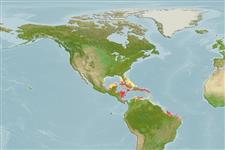>
Gobiiformes (Gobies) >
Gobiidae (Gobies) > Gobiinae
Etymology: Coryphopterus: Greek, koryphe = summit + Greek, pteron = fin, wing (Ref. 45335); kuna: Named for the Kuna indigenous people of the Kuna Yala, the region of Atlantic Panama in which the holotype was collected, in recognition of their cooperation in marine biological research. Although
is masculine, kuna is a noun in app.
Environment: milieu / climate zone / depth range / distribution range
Écologie
marin benthopélagique; profondeur 10 - 30 m (Ref. 58754). Tropical
Western Atlantic: coasts of Panama and Mexico (Ref. 58754). Recently found in Utila, Honduras (Ref. 93936), Carrie Bow Cay, Belize (Ref. 93938), and Lake Worth Lagoon, Palm Beach, Florida (Ref. 93936).
Length at first maturity / Taille / Poids / Âge
Maturity: Lm 1.0, range 1 - 1.1 cm
Max length : 1.7 cm SL mâle / non sexé; (Ref. 58754)
Description synthétique
Clés d'identification | Morphologie | Morphométrie
Épines dorsales (Total) : 7; Rayons mous dorsaux (Total) : 8; Épines anales: 1; Rayons mous anaux: 8; Vertèbres: 26. Most distinctive character: two rows of small black spots across the upper aspect of the eye: 4-6 on the outer row and 2-3 on the medial row (Ref. 93936).
Adults are found in exposed sandbeds (Ref. 93936), An elusive species for It occupies an obscure habitat:and was collected in deeper water than is usually surveyed, it was far from reef substrate, and the area is subject to some siltation from the Panamanian mainland. The species is also not particularly different-looking from the usual sand-bed gobies that it would not attract attention (Ref. 58754) .Depth at 15 - 20 m (Ref. 58754), range given by B. Victor (pers.comm. 10/18).
Victor, B.C., 2007. Coryphopterus kuna, a new goby (Perciformes: Gobiidae: Gobiinae) from the western Caribbean, with the identification of the late larval stage and an estimate of the pelagic larval duration. Zootaxa 1526:51-61. (Ref. 58754)
Statut dans la liste rouge de l'IUCN (Ref. 130435)
Menace pour l'homme
Harmless
Utilisations par l'homme
Outils
Articles particuliers
Télécharger en XML
Sources Internet
Estimates based on models
Phylogenetic diversity index (Ref.
82804): PD
50 = 0.5001 [Uniqueness, from 0.5 = low to 2.0 = high].
Bayesian length-weight: a=0.01023 (0.00477 - 0.02194), b=3.02 (2.84 - 3.20), in cm total length, based on LWR estimates for this (Sub)family-body shape (Ref.
93245).
Niveau trophique (Ref.
69278): 3.0 ±0.4 se; based on size and trophs of closest relatives
Résilience (Ref.
120179): Haut, temps minimum de doublement de population inférieur à 15 mois (Preliminary K or Fecundity.).
Fishing Vulnerability (Ref.
59153): Low vulnerability (10 of 100).
